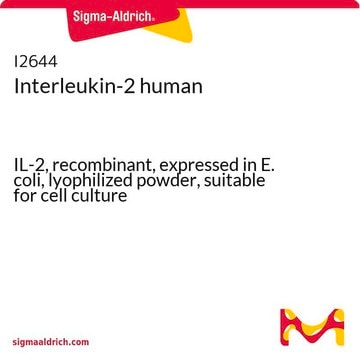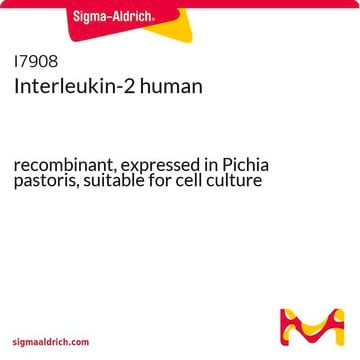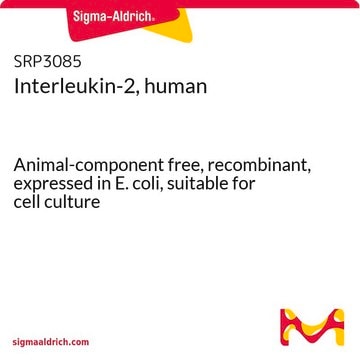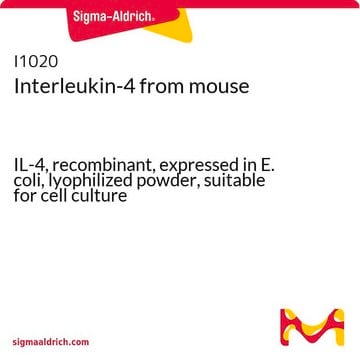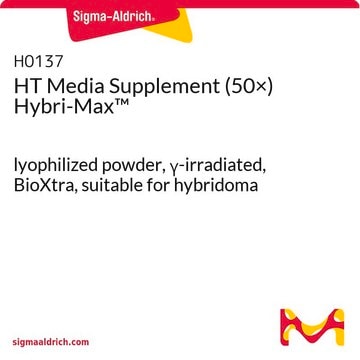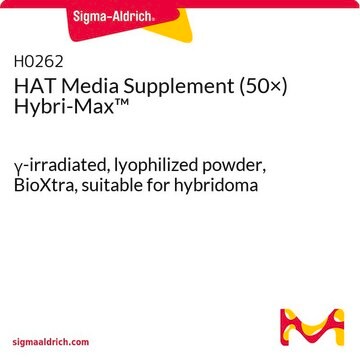11271164001
Roche
Interleukin-2, mouse (mIL-2)
recombinant (E. coli)
Sinonimo/i:
mIL-2, mouse interleukin-2
About This Item
Prodotti consigliati
Origine biologica
mouse
Livello qualitativo
Ricombinante
expressed in E. coli
Saggio
>95% (SDS-PAGE)
Forma fisica
solution
Potenza
<0.5 ng/mL EC50
PM
17,200 Da
Confezionamento
pkg of 10,000 U (5 μg, 1 ml)
Produttore/marchio commerciale
Roche
Condizioni di stoccaggio
avoid repeated freeze/thaw cycles
tecniche
inhibition assay: suitable
Impurezze
<0.1 EU/μgtested (LAL test)
N° accesso UniProt
Temperatura di conservazione
−20°C
Informazioni sul gene
mouse ... Il2(16183)
Categorie correlate
Descrizione generale
Specificità
Applicazioni
- Supports the growth of murine CTLL cells (murine T cell line), but not that of human T-cells.
- Strongly inhibits the binding of recombinant human IL-2 to murine responder cells.
- Weakly inhibits the binding to human responder cells.
- Shares identical biological and immunological activities with human IL-2.
- Is a convenient tool for extensive studies of the pharmacological and physiological activities of IL-2 in murine models.
- used for the stimulation of murine T-cells
Qualità
Sequenza
Definizione di unità
Nota sulla preparazione
Storage conditions (working solution): -15 to -25 °C
Note: Avoid repeated freezing and thawing.
Altre note
Note: The biological activity of this product may vary in different in vitro applications. Determine the optimal concentration range for specific applications.
EC 50 definition/Unit definition: The amount of mIL-2 that is required to support half-maximal stimulation of cell proliferation (XTT cleavage) with CTLL-2 cells (1 unit equals =0.5 ng).
Codice della classe di stoccaggio
12 - Non Combustible Liquids
Classe di pericolosità dell'acqua (WGK)
nwg
Punto d’infiammabilità (°F)
No data available
Punto d’infiammabilità (°C)
No data available
Certificati d'analisi (COA)
Cerca il Certificati d'analisi (COA) digitando il numero di lotto/batch corrispondente. I numeri di lotto o di batch sono stampati sull'etichetta dei prodotti dopo la parola ‘Lotto’ o ‘Batch’.
Possiedi già questo prodotto?
I documenti relativi ai prodotti acquistati recentemente sono disponibili nell’Archivio dei documenti.
I clienti hanno visto anche
Il team dei nostri ricercatori vanta grande esperienza in tutte le aree della ricerca quali Life Science, scienza dei materiali, sintesi chimica, cromatografia, discipline analitiche, ecc..
Contatta l'Assistenza Tecnica.

